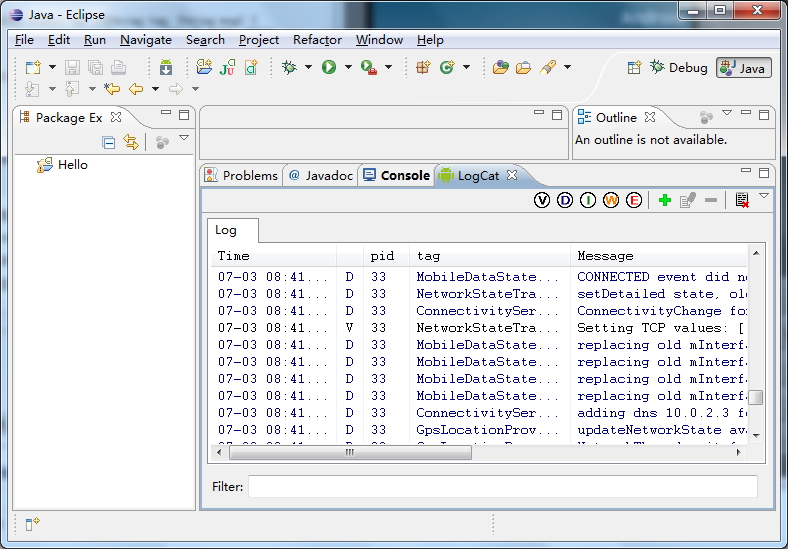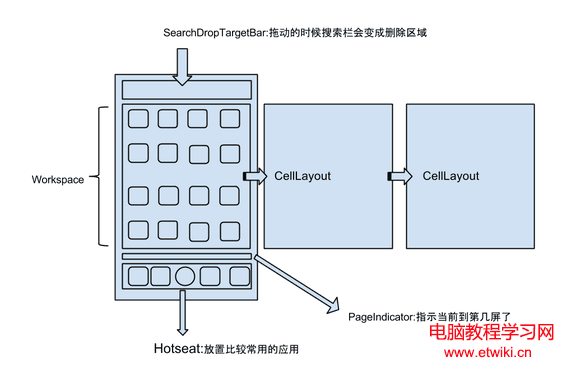編輯:關於Android編程
在程序開發過程中,LOG是廣泛使用的用來記錄程序執行過程的機制,它既可以用於程序調試,也可以用於產品運營中的事件記錄。在Android系統中,提供了簡單、便利的LOG機制,開發人員可以方便地使用。在這一篇文章中,我們簡單介紹在Android內核空間和用戶空間中LOG的使用和查看方法。
一. 內核開發時LOG的使用。Android內核是基於Linux Kerne 2.36的,因此,Linux Kernel的LOG機制同樣適合於Android內核,它就是有名的printk,與C語言的printf齊名。與printf類似,printk提供格式化輸入功能,同時,它也具有所有LOG機制的特點--提供日志級別過慮功能。printk提供了8種日志級別(<linux/kernel.h>):
#define KERN_EMERG "<0>" /* system is unusable */ #define KERN_ALERT "<1>" /* action must be taken immediately */ #define KERN_CRIT "<2>" /* critical conditions */ #deinfe KERN_ERR "<3>" /* error conditions */ #deinfe KERN_WARNING "<4>" /* warning conditions */ #deinfe KERN_NOTICE "<5>" /* normal but significant condition */ #deinfe KERN_INFO "<6>" /* informational */ #deinfe KERN_DEBUG "<7>" /* debug-level messages */
printk的使用方法:
printk(KERN_ALERT"This is the log printed by printk in linux kernel space.");
KERN_ALERT表示日志級別,後面緊跟著要格式化字符串。
在Android系統中,printk輸出的日志信息保存在/proc/kmsg中,要查看/proc/kmsg的內容,參照Android內核源碼 在Ubuntu上下載,編譯,安裝一文,在後台中運行模擬器:
USER-NAME@MACHINE-NAME:~/Android$ emulator &
啟動adb shell工具:
USER-NAME@MACHINE-NAME:~/Android$ adb shell
查看/proc/kmsg文件:
root@android:/ # cat /proc/kmsg
二. 用戶空間程序開發時LOG的使用。Android系統在用戶空間中提供了輕量級的logger日志系統,它是在內核中實現的一種設備驅動,與用戶空間的logcat工具配合使用能夠方便地跟蹤調試程序。在Android系統中,分別為C/C++ 和Java語言提供兩種不同的logger訪問接口。C/C++日志接口一般是在編寫硬件抽象層模塊或者編寫JNI方法時使用,而Java接口一般是在應用層編寫APP時使用。
Android系統中的C/C++日志接口是通過宏來使用的。在system/core/include/android/log.h定義了日志的級別:
/*
* Android log priority values, in ascending priority order.
*/
typedef enum android_LogPriority {
ANDROID_LOG_UNKNOWN = 0,
ANDROID_LOG_DEFAULT, /* only for SetMinPriority() */
ANDROID_LOG_VERBOSE,
ANDROID_LOG_DEBUG,
ANDROID_LOG_INFO,
ANDROID_LOG_WARN,
ANDROID_LOG_ERROR,
ANDROID_LOG_FATAL,
ANDROID_LOG_SILENT, /* only for SetMinPriority(); must be last */
} android_LogPriority;
在system/core/include/cutils/log.h中,定義了對應的宏,如對應於ANDROID_LOG_VERBOSE的宏LOGV:
/* * This is the local tag used for the following simplified * logging macros. You can change this preprocessor definition * before using the other macros to change the tag. */ #ifndef LOG_TAG #define LOG_TAG NULL #endif /* * Simplified macro to send a verbose log message using the current LOG_TAG. */ #ifndef LOGV #if LOG_NDEBUG #define LOGV(...) ((void)0) #else #define LOGV(...) ((void)LOG(LOG_VERBOSE, LOG_TAG, __VA_ARGS__)) #endif #endif /* * Basic log message macro. * * Example: * LOG(LOG_WARN, NULL, "Failed with error %d", errno); * * The second argument may be NULL or "" to indicate the "global" tag. */ #ifndef LOG #define LOG(priority, tag, ...) \ LOG_PRI(ANDROID_##priority, tag, __VA_ARGS__) #endif /* * Log macro that allows you to specify a number for priority. */ #ifndef LOG_PRI #define LOG_PRI(priority, tag, ...) \ android_printLog(priority, tag, __VA_ARGS__) #endif /* * ================================================================ * * The stuff in the rest of this file should not be used directly. */ #define android_printLog(prio, tag, fmt...) \ __android_log_print(prio, tag, fmt)
因此,如果要使用C/C++日志接口,只要定義自己的LOG_TAG宏和包含頭文件system/core/include/cutils/log.h就可以了:
#define LOG_TAG "MY LOG TAG"
#include <cutils/log.h>
就可以了,例如使用LOGV:
LOGV("This is the log printed by LOGV in android user space.");
再來看Android系統中的Java日志接口。Android系統在Frameworks層中定義了Log接口:
(frameworks/base/core/java/android/util/Log.java):
................................................
public final class Log {
................................................
/**
* Priority constant for the println method; use Log.v.
*/
public static final int VERBOSE = 2;
/**
* Priority constant for the println method; use Log.d.
*/
public static final int DEBUG = 3;
/**
* Priority constant for the println method; use Log.i.
*/
public static final int INFO = 4;
/**
* Priority constant for the println method; use Log.w.
*/
public static final int WARN = 5;
/**
* Priority constant for the println method; use Log.e.
*/
public static final int ERROR = 6;
/**
* Priority constant for the println method.
*/
public static final int ASSERT = 7;
.....................................................
public static int v(String tag, String msg) {
return println_native(LOG_ID_MAIN, VERBOSE, tag, msg);
}
public static int v(String tag, String msg, Throwable tr) {
return println_native(LOG_ID_MAIN, VERBOSE, tag, msg + '\n' + getStackTraceString(tr));
}
public static int d(String tag, String msg) {
return println_native(LOG_ID_MAIN, DEBUG, tag, msg);
}
public static int d(String tag, String msg, Throwable tr) {
return println_native(LOG_ID_MAIN, DEBUG, tag, msg + '\n' + getStackTraceString(tr));
}
public static int i(String tag, String msg) {
return println_native(LOG_ID_MAIN, INFO, tag, msg);
}
public static int i(String tag, String msg, Throwable tr) {
return println_native(LOG_ID_MAIN, INFO, tag, msg + '\n' + getStackTraceString(tr));
}
public static int w(String tag, String msg) {
return println_native(LOG_ID_MAIN, WARN, tag, msg);
}
public static int w(String tag, String msg, Throwable tr) {
return println_native(LOG_ID_MAIN, WARN, tag, msg + '\n' + getStackTraceString(tr));
}
public static int w(String tag, Throwable tr) {
return println_native(LOG_ID_MAIN, WARN, tag, getStackTraceString(tr));
}
public static int e(String tag, String msg) {
return println_native(LOG_ID_MAIN, ERROR, tag, msg);
}
public static int e(String tag, String msg, Throwable tr) {
return println_native(LOG_ID_MAIN, ERROR, tag, msg + '\n' + getStackTraceString(tr));
}
..................................................................
因此,如果要使用Java日志接口,只要在類中定義的LOG_TAG常量和引用android.util.Log就可以了:
private static final String LOG_TAG = "MY_LOG_TAG";
Log.i(LOG_TAG, "This is the log printed by Log.i in android user space.");
要查看這些LOG的輸出,可以配合logcat工具。如果是在Eclipse環境下運行模擬器,並且安裝了Android插件,那麼,很簡單,直接在Eclipse就可以查看了:

如果是在自己編譯的Android源代碼工程中使用,則在後台中運行模擬器:
USER-NAME@MACHINE-NAME:~/Android$ emulator &
啟動adb shell工具:
USER-NAME@MACHINE-NAME:~/Android$ adb shell
使用logcat命令查看日志:
root@android:/ # logcat
這樣就可以看到輸出的日志了。
以上就是Android 自己的LOG信息實現方法,有需要的朋友看下。
 android apk獲取root權限執行相應的操作
android apk獲取root權限執行相應的操作
在apk中,有時候需要root權限,例如通過apk更新系統庫等system的文件等,避免升級固件,或者在apk中需要直接訪問某些設備等。下面是在apk中獲取root權限的
 Android手機——讀取手機電話+短信+網頁+圖片+音樂+視頻+APK+通知欄消息+換頭像
Android手機——讀取手機電話+短信+網頁+圖片+音樂+視頻+APK+通知欄消息+換頭像
<uses-permission android:name="android.permission.CALL_PHONE"/><us
 android上line-height的問題
android上line-height的問題
關於line-height大家應該非常熟悉了吧,就是用來做垂直居中的,屢試不爽,基本上沒有什麼問題,但是最近一個項目,測試提了一個bug,看圖吧。從別處竊的圖,這個問題只
 Android Launcher原理分析
Android Launcher原理分析
基本概念本文主要講述Launcher3屏幕滑動過程,首先需要了解Android的觸摸事件分發機制。關於分發機制,可查看文章Android事件分發機制。常用類